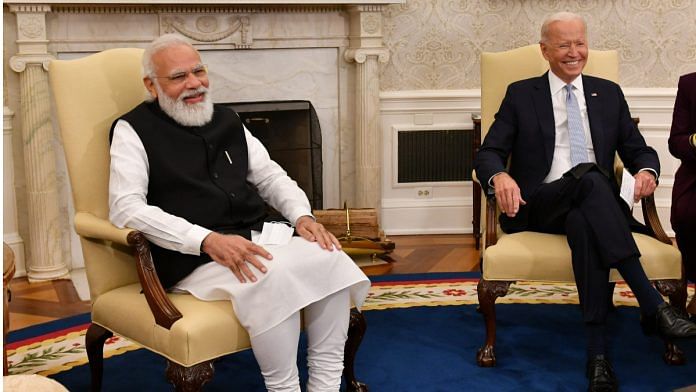Prime Minister Narendra Modi will arrive in the United States of America on 21 June for his first official state visit. The PM’s schedule will span two cities, New York and Washington DC, and include a state dinner, joint address to the US Congress, and diaspora engagements. But beyond the pomp and show, Modi’s visit promises to elevate the US-India defence relationship to the next level and includes key deliverables that will set the stage for the coming years. From jet engines to semiconductor chips and scientific collaboration, Modi-Biden mean business.
A state dinner is the highest diplomatic reception generally hosted for close allies. In the past year, Biden has hosted South Korean and French leaders. Modi is also one of the few leaders (others being Nelson Mandela, Winston Churchill and Benjamin Netanyahu) to address the joint session of Congress twice. The visit also shows bipartisan support for the US-India relationship and is a symbol of their diplomatic alignment on key strategic issues.
Sharp focus on defence tech
The upward trajectory of the relationship between the two countries is best reflected in the progress made in our defence ties and Modi’s visit promises to elevate this partnership to the next level. From barely any bilateral trade in 2008 to an impressive $ 20 billion in 2020, the defence ties between the two countries have come a long way. The two sides have signed all four foundational agreements and the US is presently India’s largest bilateral and multilateral exercise partner. However, on defence technology and innovation, we have made modest inroads despite the extensive review of export controls following the High Technology Cooperation Group and the defense technology and trade initiative.
Today, the two sides are actively talking about enmeshing their defense technology and innovation ecosystems together. Launched in January, a national security advisors’-led US-India initiative on critical and emerging technology (iCET) focuses on collaboration in areas like artificial intelligence, quantum computing, space exploration, semiconductors, and defence technology.
In March, US secretary of commerce Gina Raimondo and India’s minister of commerce and industry Piyush Goyal signed a bilateral partnership on the semiconductor supply chain in New Delhi. And US defense secretary Lloyd Austin’s recent visit to India resulted in the announcement of INDUS-X, which stands for enhanced defense partnership between the two countries. INDUS-X will be launched on the sidelines of Modi’s visit at a two-day event hosted by the U.S.-India Business Council and Washington-based think tank IndUS Tech Council is one of the key stakeholder organisations in this initiative. In the past month, Indian defence secretary Giridhar Aramane and his delegation visited Washington DC for the defence policy dialogue and foreign secretary Vinay Kwatra and his delegation ironed out export control issues during the strategic trade dialogue. Finally, just a week before Modi’s visit to the US, the national security advisor of the US Jake Sullivan was in New Delhi.
Also read: Question ahead of Modi’s US visit—Will India abandon multipolarity, become a camp follower?
Key deliverables
The defense industrial roadmap will be in focus during Modi’s state visit, and INDUS-X will help forge an innovation bridge between the defence and technology ecosystems of the two countries by linking startups, investors, and academia. Some of the key deliverables will include likely movement on the GE F414 jet engines coproduction deal and the MQ9 sea guardian drones by General Atomics. An announcement on a new semiconductor assembly packaging and testing facility in Gujarat is also expected. Many new initiatives will also be started as part of INDUS-X, namely, joint challenges between Indian ministry of defence’s Innovation for Defence Excellence (iDEX) and the US department of defense’s Defense Innovation Unit (DIU); pathways for mentor protégé relationships between US primes and Indian startups; a joint innovation fund; academia linkages; research and laboratory testing collaboration; and more.
Cooperation on high technology will manifest in many ways and the two sides are also actively working on easing export control restrictions to ease partnerships in the private sector. Notably, International Traffic in Arms Regulations (ITAR) and Defense Federal Acquisition Regulation Supplement (DFARS) are on the table.
An ITAR licence is generally required for the transfer of sensitive technologies from the US. Indian firms can benefit from India-specific exemptions, and a more transparent and time-bound licencing process. As India is not a DFARS-qualifying country, the country’s firms cannot supply to the US department of defense under traditional acquisition methods. A reciprocal defense procurement agreement can make India qualify.
Easing export control and other regulations can make the pathway for co-development and coproduction much smoother and open the US defence market to Indian firms.
Also read: Why Western charm offensive for Modi is proof of PM walking foreign policy middle path
Stage for the next phase
The defence innovation bridge presents a great opportunity to strengthen US-India relations to fight common strategic and technological challenges. For the US, it brings supply chain resilience, a skilled workforce, and cost efficiency. For India stands to benefit from, it holds the promise of investments for startups and increased transfer of technology.
A startup-driven US-India defence innovation agenda represents the democratised supply chains and innovation paradigms of the future. However, as the United States shows openness to provide access to the its defence and technology ecosystem, India will also have to provide some access, especially if the two sides are to come to a reciprocal defence procurement agreement.
Watchers of the US-India bilateral ties are always cautious when new initiatives and acronyms are tossed around. But the willingness on both sides to work together on the strategic relationship is evident. and Modi’s visit will set the stage for the next phase in our strategic ties—which is led by the private sector and focused on democratising defence and technology innovation.
Kriti Upadhyaya is vice president of strategic advisory at C2Ci Americas and the founding
director of IndUS Tech Council. IndUS Tech Council is a partner organization in INDUS X.Views are personal.
(Edited by Ratan Priya)



